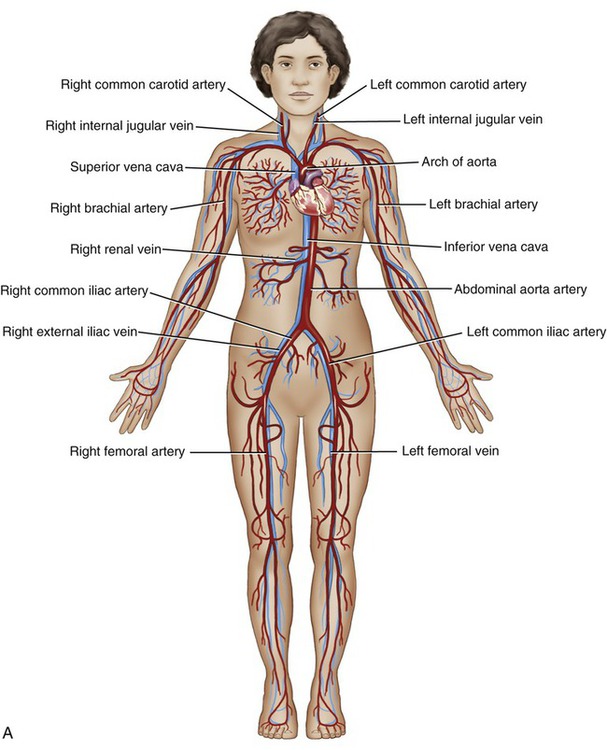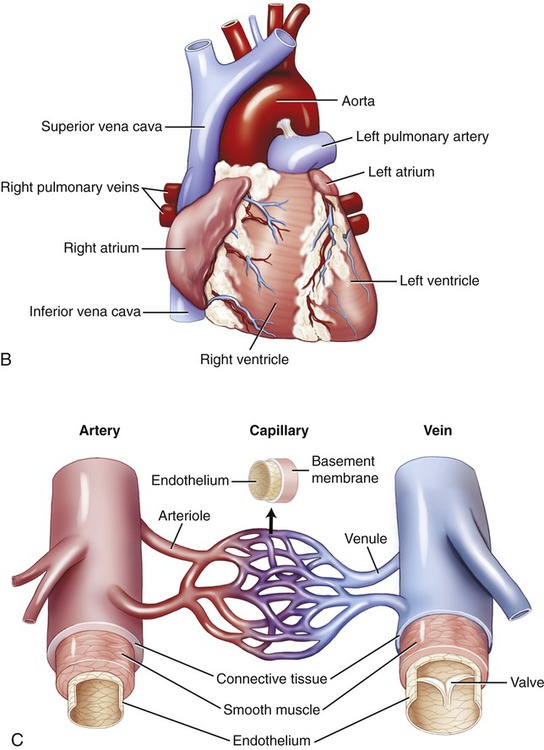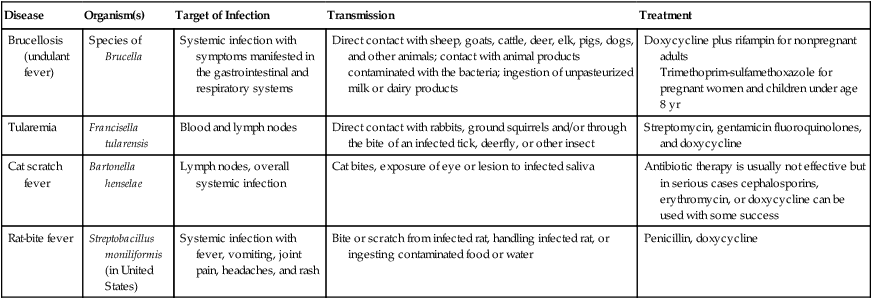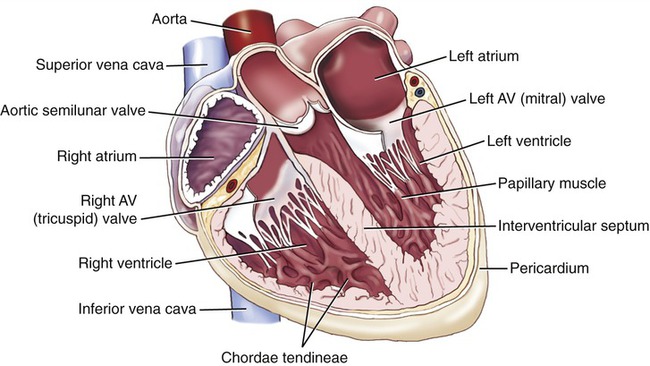Infections of the Circulatory System
After reading this chapter, the student will be able to:
• Identify the causes and symptoms of endocarditis, myocarditis, and pericarditis
• Describe blood-borne infectious diseases and microbemia
• Differentiate between bacteremia and septicemia
• Describe the transmission, symptoms, and treatment of rheumatic fever and gangrene
• Discuss zoonotic bacterial infections
• Describe the vector-transmitted bacterial diseases affecting the circulatory system
• Describe the cause, transmission, symptoms, and treatment for infectious mononucleosis
• Describe the causes and symptoms of viral hemorrhagic fevers
• Discuss the causes, symptoms, and treatment of systemic mycoses
• Describe the origin and transmission of the different protozoan infections that affect the circulatory system
Introduction
The circulatory system includes the cardiovascular system and the lymphatic system. The lymphatic system consists of the lymph, lymphatic vessels, lymphatic tissue, and lymphatic organs, and is discussed in Chapter 20 (The Immune System). The cardiovascular system consists of the heart, blood, and blood vessels (Figure 14.1). Infection and inflammation of the cardiovascular system frequently cause cardiac and vascular disease. The lymphatic system returns excess tissue fluid back to the cardiovascular system and therefore has direct access to the cardiovascular system. The relationship between the cardiovascular and lymphatic systems is illustrated in Figure 14.2. Once microorganisms gain access to either one of the systems they can spread throughout the body and therefore have the potential to infect any organ system. In general, bacterial and fungal infections will affect the endocardium (tissue lining of the heart chambers), causing endocarditis, whereas viral and parasitic infections affect the myocardium (heart muscle), resulting in myocarditis. Inflammation and infection of the pericardium (membrane surrounding the heart), called pericarditis, can be caused by bacteria, viruses, and rarely by fungi.


A, The cardiovascular system consists of the heart (B) and the blood and blood vessels (C).

A, The lymphatic vessels drain excess fluid from the tissues and return it to the cardiovascular system. B, The inset shows the relationship between the blind-ended lymphatic capillaries and the blood capillaries.
Endocarditis
Endocarditis is an inflammation of the endocardium, the lining of the heart or the heart valves (Figure 14.3). The condition can be classified as infective if a microorganism is involved, or as noninfective. Noninfective endocarditis involves the formation of platelet and fibrin thrombi on heart valves and the surrounding endocardium, in response to trauma, circulating immune complexes, vasculitis, or a hypercoagulated state. Infective endocarditis symptoms may develop slowly (subacute) or suddenly and they include the following:
Pericarditis
Pericarditis is the term used to describe inflammation of the pericardium, the saclike membrane surrounding the heart (see Figure 14.3). The condition is usually a result of complications of a viral infection, but can also be caused by bacteria and fungi. The symptoms include the following:
Blood-borne Infectious Diseases
Blood-borne disease is spread by contaminated blood or bodily fluids. Any exposure to blood or other bodily fluids can transmit infectious disease. Although blood-borne diseases can affect anyone exposed to infected blood or bodily fluids, the risk of exposure is greater with certain occupations such as healthcare, emergency response, public safety, teaching, and many others (see Chapter 5, Safety Issues). Pathogens of primary concern for these professions, according to the Centers for Disease Control and Prevention (CDC, Atlanta, GA), are HIV, hepatitis B virus, hepatitis C virus, and those causing viral hemorrhagic fever. These viruses are discussed in detail in Chapter 17 (Sexually Transmitted Infections/Diseases). Diseases that are not transmitted directly by blood or by contact with bodily fluids, but by an insect or other vector, are classified as vector-borne diseases.
Bacterial Infections
Once bacteria have access to the circulatory system they become widely dispersed (bacteremia) and are capable of infecting a wide range of tissues and organs. If the bacteria in the circulatory system are not destroyed by the immune system or by antibiotic treatment, they can multiply in the blood and cause septicemia. Examples of bacterial diseases of the circulatory system are illustrated in Table 14.1.
TABLE 14.1
Bacterial Diseases of the Circulatory System
| Disease | Organism | Target of Infection | Transmission | Treatment |
| Rheumatic fever | Group A Streptococcus | Heart, joints, brain, spinal cord, skin | Coughing, sneezing, saliva | Penicillin, erythromycin, oral cephalosporin, vancomycin, oxacillin |
| Gas gangrene | Clostridium perfringens | Extremities, muscle tissues, and organs | Wound contact with soil | Removal of necrotic tissue, including amputation |

Bacteremia
Blood is normally sterile, but microorganisms can enter the blood under a variety of conditions. Bacteremia is the term used when bacteria are present in the bloodstream (see Chapter 9, Infection and Disease). Bacteremia has various possible causes including infection during dental procedures, catheterization and the placement of other indwelling devices, surgical procedures, wound infection, and many more. In general, the presence of bacteria in the blood elicits a strong immune response by circulating macrophages, the complement system, and lymphocytes (see Chapter 20, The Immune System), thus preventing bacteria from multiplying. In addition, the blood is relatively low on iron, a requirement for most bacterial growth. If the defenses of the immune and circulatory systems fail microbes can undergo uncontrolled proliferation in the blood, causing a condition called septicemia.
Septicemia
Sepsis is a toxic condition caused by the spread of bacteria or bacterial toxins from the site of infection (see Chapter 9, Infection and Disease). Septicemia is sepsis that occurs when bacteria multiply in the bloodstream. Septicemia is a medical emergency that requires immediate medical treatment. If the condition progresses to septic shock the death rate is as high as 50%, depending on the type of organism involved. Septic shock is the result of hypotension (low blood pressure) despite adequate fluid substitution. Septicemia develops quickly and the patient becomes extremely ill. Although each individual may experience symptoms differently the most common symptoms include the following:
Rheumatic Fever
Rheumatic fever is an inflammatory disease that can develop as a rare complication after a group A streptococcal infection such as strep throat or scarlet fever (see Chapter 11, Medical Highlights: Complications of “Strep Throat”). The condition commonly involves the heart, joints, brain, spinal cord, and skin. In general, rheumatic fever occurs in children between the ages of 4 and 18 years. Symptoms normally begin several weeks after the disappearance of localized throat symptoms and vary greatly between individuals, depending on the parts of the body inflamed. The most common symptoms include the following:
Gangrene
Gangrene is a complication of necrosis, the decay and death of tissue, that is often related to wounds. If the blood supply to a tissue is interrupted by an infection or ischemia (restriction of blood supply) gangrene can occur. Gangrene most commonly affects the extremities (Figure 14.4); however, it can also occur in muscle tissue and organs. Enzymes released from the dying cells and tissue will further destroy the surrounding tissues and thus provide a perfect nutrient environment for many bacterial species. Tissues devoid of blood supply become ischemic and provide an environment for anaerobic bacteria. Several species of the genus Clostridium, gram-positive, endospore-forming anaerobes, grow easily under these conditions. Clostridium is commonly found in soil as well as in the intestinal tracts of humans and domestic animals. The most frequent species involved in gangrene is C. perfringens, but other species and several other genera of bacteria can also grow under the conditions mentioned.
There are different types of gangrene, including the following:
• Dry gangrene, due to ischemia and generally beginning at the distal portions of a limb such as in the feet. This condition often occurs in elderly patients with arteriosclerosis, and other persons with impaired peripheral blood flow, such as diabetic patients.
• Internal gangrene, also called white gangrene, is noticeable by the bleaching of internal tissue, and is generally contracted after surgery or trauma.
• Wet gangrene occurs in organs lined by mucous membranes such as the mouth, lower intestinal tract, lungs, and cervix. Although not necessarily associated with moist tissue, bedsores are also categorized as wet gangrene infections. Toxic products formed by the infecting bacteria can be absorbed if the affected tissue is not removed, resulting in septicemia or toxemia, and eventually death.
• Gas gangrene is caused by bacteria that produce gas within the infected tissue. Toxins produced by the bacteria will cause necrosis of more tissue, thereby providing further bacterial growth. If untreated, the condition is fatal.
Zoonotic Diseases
Any disease and/or infection that can be transmitted from vertebrate animals to humans is classified as a zoonosis. More than 200 zoonoses have been described, but not all affect the circulatory system (Table 14.2). Zoonoses may be caused by bacteria, viruses, parasites, and unconventional agents such as prions. The emerging field of conservation medicine integrates human medicine, veterinary medicine, and environmental services and is largely concerned with zoonoses.
TABLE 14.2
Zoonotic Infections of the Circulatory System
| Disease | Organism(s) | Target of Infection | Transmission | Treatment |
| Brucellosis (undulant fever) | Species of Brucella | Systemic infection with symptoms manifested in the gastrointestinal and respiratory systems | Direct contact with sheep, goats, cattle, deer, elk, pigs, dogs, and other animals; contact with animal products contaminated with the bacteria; ingestion of unpasteurized milk or dairy products | Doxycycline plus rifampin for nonpregnant adults Trimethoprim-sulfamethoxazole for pregnant women and children under age 8 yr |
| Tularemia | Francisella tularensis | Blood and lymph nodes | Direct contact with rabbits, ground squirrels and/or through the bite of an infected tick, deerfly, or other insect | Streptomycin, gentamicin fluoroquinolones, and doxycycline |
| Cat scratch fever | Bartonella henselae | Lymph nodes, overall systemic infection | Cat bites, exposure of eye or lesion to infected saliva | Antibiotic therapy is usually not effective but in serious cases cephalosporins, erythromycin, or doxycycline can be used with some success |
| Rat-bite fever | Streptobacillus moniliformis (in United States) | Systemic infection with fever, vomiting, joint pain, headaches, and rash | Bite or scratch from infected rat, handling infected rat, or ingesting contaminated food or water | Penicillin, doxycycline |




